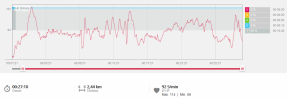Bauer
Level 8 Valued Member
Hi folks,
yesterday I decided to try rucking with 10 kg (22 lbs) and just walked "purposefully" for about half an hour. I covered 2.7 km (1.7 miles), thus with a pace of about 5kmh (19 minute/mile or so). The weight felt good, but nonetheless my shoulders got a bit tight.
What surprised me was my low average HR: 85 BPM.

The "spikes" were some bridges I crossed.
For some periods I increased my pace (probably 17:00 pace), but my HR only increased 3-5 beats. Interestingly, I am known as a rather fast walker.
Al Ciampa recommends about 130 BPM Average HR
I don't know what to make of this. Obviously, a hilly terrain would be better. I should add that I have a low resting HR (~40 BPM in the morning) and that I am used to carrying my daughter (13 kgs) for some time in a a carrier. When I do sets of 10 KB Swings my HR goes up to roughly 130 or 140.
I guess it is still a healthy endeavour, but maybe not stretching my heart that much. What is your take? What is your experience with rucking an HR?
As for goals, I would like to add it for (a) relaxation and recovery, and (b) general aerobic fitness. My original plan was to spend 60-90 minutes per week within 110-130 BPM HR.
yesterday I decided to try rucking with 10 kg (22 lbs) and just walked "purposefully" for about half an hour. I covered 2.7 km (1.7 miles), thus with a pace of about 5kmh (19 minute/mile or so). The weight felt good, but nonetheless my shoulders got a bit tight.
What surprised me was my low average HR: 85 BPM.

The "spikes" were some bridges I crossed.
For some periods I increased my pace (probably 17:00 pace), but my HR only increased 3-5 beats. Interestingly, I am known as a rather fast walker.
Al Ciampa recommends about 130 BPM Average HR
Source: Rucking: What It Is and How to Do It | StrongFirstIf you decide to add rucking to your training, please, start out light and short, depending upon your experience. However strong or conditioned you currently are, if you’ve never endured under a load, you will run the risk of joint pain or injury. Start out with a distance between 2-4 miles, carrying 15-25lbs of weight. Walk once per week, and increase only one of these variables each week: either 5-10lbs or 1-2 miles.
Use nasal breathing to guide your pace – you literally should be able to keep a conversation going. For basic fitness conditioning, working up to 60 minute ruck once per week, with a load that gets your heart rate to an average of 125-135bpm (age dependent) is sufficient. You can use a heart rate monitor or the “180 minus your age” formula to calculate your target, but there’s no need to get particular about it.
I don't know what to make of this. Obviously, a hilly terrain would be better. I should add that I have a low resting HR (~40 BPM in the morning) and that I am used to carrying my daughter (13 kgs) for some time in a a carrier. When I do sets of 10 KB Swings my HR goes up to roughly 130 or 140.
I guess it is still a healthy endeavour, but maybe not stretching my heart that much. What is your take? What is your experience with rucking an HR?
As for goals, I would like to add it for (a) relaxation and recovery, and (b) general aerobic fitness. My original plan was to spend 60-90 minutes per week within 110-130 BPM HR.


